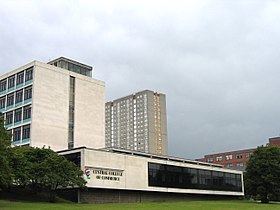Enrollment c600 Color Navy and Sky Blue | ||
 | ||
Opened 1853; ceasd to be a selective school 1973, closed 1989 Principal The final Headmaster during the selective period of the school's existence was Ralph Finlayson Motto "Cum Scientia Humanitas" (Science with Compassion) | ||
Allan Glen's School was, for most of its existence, a local authority, selective secondary school for boys in Glasgow, Scotland, charging nominal fees for tuition.
Contents
- Schools evolution
- Glasgow corporation
- Merger with City Public School
- City of Glasgow College
- Playing fields
- Notable alumni
- References
It was founded by the Allan Glen's Endowment Scholarship Trust on the death, in 1850, of Allan Glen, a successful Glasgow tradesman and businessman, "to give a good practical education and preparation for trades or businesses, to between forty to fifty boys, the sons of tradesmen or persons in the industrial classes of society". The School was formally established in 1853 and located in the Townhead district of the city, on land that Glen had owned on the corner of North Hanover Street and Cathedral Street.
School's evolution
Although notionally fee-paying, the school offered a large number of bursaries and enrolled pupils from all social classes, selected on the basis of academic ability. The school's emphasis on science and engineering led to it becoming, in effect, Glasgow's High School of Science. As such, in 1887 its management merged with the nearby Anderson's College to form the Glasgow and West of Scotland Technical College which later became the Royal Technical College in 1912, the Royal College of Science and Technology in 1956, and ultimately the University of Strathclyde in 1964. By the end of 1888 a new building was ready for the school in North Hanover Street.
Glasgow corporation
In 1912, the school was transferred from the newly designated Royal Technical College to the School Board of Glasgow run by Glasgow Corporation. Parents who paid domestic or business rates to Glasgow Corporation were charged a much reduced fee, enabling children from less wealthy households, but who had passed the entrance exam, to benefit from the high standard of teaching at the school. In 1923, playing fields were acquired for the school in the suburb of Bishopbriggs and in 1926 the school itself moved into the building previously occupied by Provanside Public School in North Montrose Street. In 1958 a new school building was planned on Cathedral Street, adjacent to the existing one. The new school building was opened in 1965.
Merger with City Public School
Selective schooling was discontinued in Scottish local authority schools in 1972, and Allan Glen's was merged with the City Public School to become a local co-educational comprehensive school on 22 August 1973, known as Allan Glen's Secondary School. Following a major re-organisation of school provision, brought about by falling birth rates, population migration and declining school rolls throughout the city, including Allan Glen's, the school was formally closed in 1989.
City of Glasgow College
Following the closure of Allan Glen's Secondary School, the buildings on Cathedral Street were converted into an annexe for the nearby Glasgow Central College of Commerce. The Cathedral Street buildings were demolished in 2013 to enable construction of new buildings for the City of Glasgow College a new entity created by the merger of three former further education Colleges, Central College, Glasgow Metropolitan College and Glasgow College of Nautical Studies.
Playing fields
The playing fields first opened at Bishopbriggs in 1923 and are still owned by the Allan Glen’s School Club. They provide the home ground for Allan Glen's Rugby Football Club, which currently plays in the West Regional League Division 1. In 2012, proposals were announced to sell part of the playing fields, following a change in the legal structure of the Trust that controls the assets of the Allan Glen's School Club.
Notable alumni
Although the school emphasised science and engineering, many of its former pupils are present throughout politics, business, industry, the arts, sciences and engineering.
